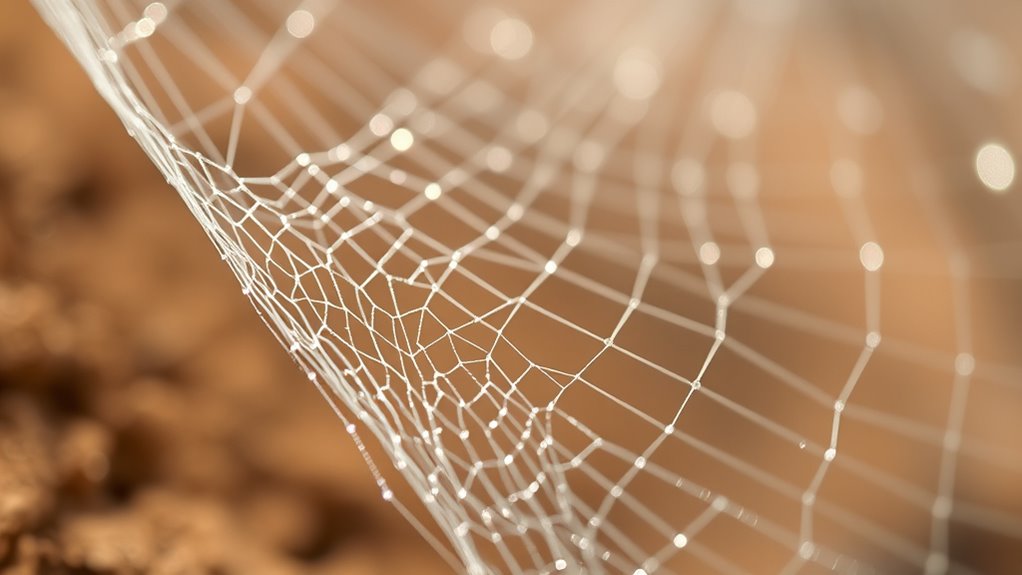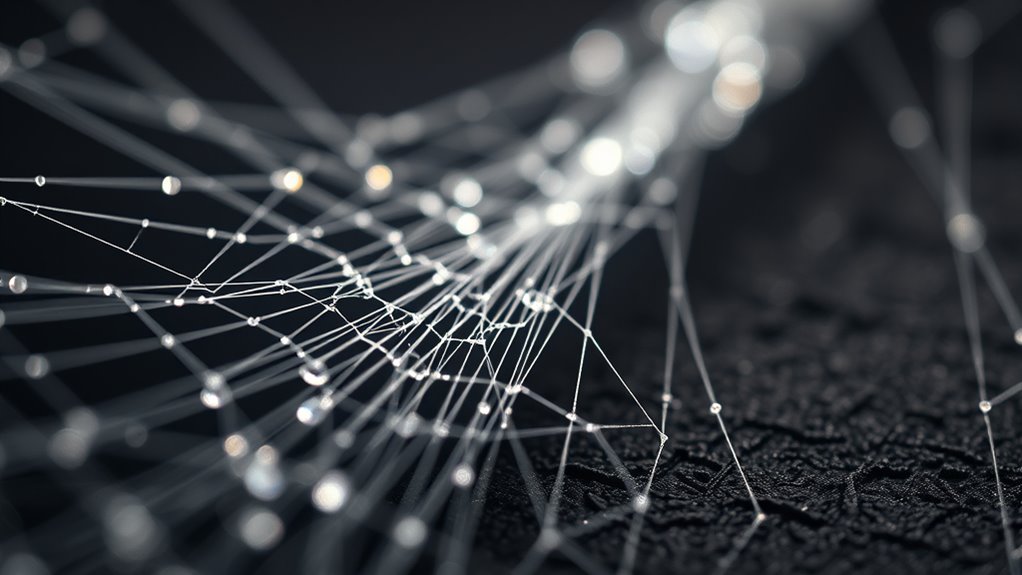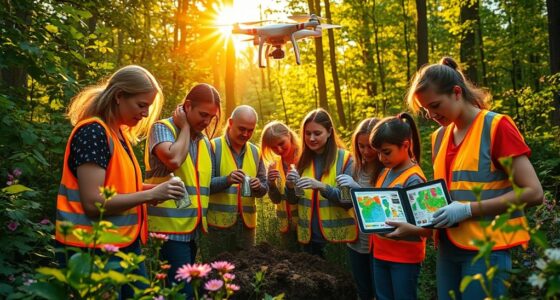Bio-inspired materials take inspiration from spider silk’s remarkable strength, flexibility, and biodegradability. Scientists use biotechnology to replicate its complex protein structures, creating sustainable, high-performance alternatives for applications like medical sutures, lightweight armor, and eco-friendly textiles. These innovative methods often reduce environmental impact and support eco-conscious development. As research advances, the potential for bio-inspired spider silk materials grows, offering exciting possibilities for sustainable industry changes. If you keep exploring, you’ll discover even more about this fascinating natural innovation.
Key Takeaways
- Spider silk’s natural strength and flexibility inspire the development of advanced bio-based materials.
- Synthetic production mimics spider silk’s complex protein structures using biotechnology.
- Bio-inspired methods offer eco-friendly, sustainable alternatives to traditional manufacturing processes.
- Applications include biodegradable textiles, medical devices, and lightweight, high-performance materials.
- Ongoing research aims to enhance scalability and real-world use of spider silk-inspired materials.

Have you ever wondered how nature’s innovations can inspire human-made materials? One fascinating example is spider silk, a marvel of natural engineering that’s been capturing scientists’ attention for years. Researchers aim to discover the secrets of spider silk to develop bio-inspired materials that can be used in countless applications, from medical devices to textiles. But to truly harness nature’s design, scientists focus on synthetic replication, trying to recreate these superior properties in a lab setting. The challenge lies in mimicking the complex protein structures that give spider silk its unique qualities while ensuring the process remains environmentally friendly. Synthetic replication of spider silk involves producing the same biopolymer chains through biotechnological methods, often using genetically engineered bacteria, yeast, or plants. This approach allows for large-scale production that’s more consistent and sustainable than harvesting silk from actual spiders, which are notoriously difficult to farm and manage. Additionally, one of the key benefits of developing synthetic spider silk is its potential to reduce the environmental impact associated with traditional material manufacturing. Unlike some synthetic fibers that require energy-intensive processes or involve toxic chemicals, bio-inspired production methods can be more eco-friendly. They often operate at lower temperatures and use renewable resources, making the entire process greener. Moreover, since spider silk is biodegradable, materials made from it are less likely to contribute to long-term pollution. This sustainable aspect not only appeals to environmentally conscious consumers but also aligns with global efforts to decrease the ecological footprint of various industries. As scientists continue to refine techniques for synthetic replication, they’re also exploring ways to improve the scalability and economic viability of producing spider silk-based materials. Advances in biotechnology are accelerating the development of these innovative materials, enabling researchers to better understand and manipulate the underlying protein structures. The potential applications are vast, from biodegradable fishing lines and parachutes to lightweight body armor and medical sutures. By learning from spider silk’s natural design, you can see how bio-inspired materials might revolutionize industries and promote sustainability. As research advances, it’s clear that mimicking nature’s innovations isn’t just about creating better products—it’s also about reducing environmental impact and fostering a more sustainable future. With continued focus on synthetic replication and eco-conscious manufacturing, spider silk stands poised to influence the next generation of high-performance, environmentally friendly materials.
Frequently Asked Questions
How Does Spider Silk Compare to Synthetic Fibers in Strength?
Spider silk is incredibly strong compared to synthetic fibers, with high fiber elasticity that allows it to stretch without breaking. You’ll find that while synthetic fibers are easier to produce at large scales, spider silk’s natural strength surpasses many man-made options. Its impressive combination of strength and elasticity makes it a promising material, but production scalability remains a challenge for widespread use.
Can Bio-Inspired Materials Be Produced at Industrial Scales?
You might think producing bio-inspired materials at industrial scales is impossible, but it’s actually a thrilling challenge! Scaling challenges exist, yet advances in manufacturing techniques are making it more feasible than ever. Imagine creating sustainable, high-performance materials inspired by nature, transforming industries and saving our planet. With innovation and determination, you could help overcome these hurdles, turning groundbreaking science into everyday solutions that revolutionize how we live and work.
What Environmental Benefits Do Bio-Inspired Materials Offer?
You’ll find that bio-inspired materials promote environmental benefits by enabling sustainable manufacturing processes. They often require less energy and fewer toxic chemicals, reducing pollution and carbon footprint. Additionally, many are biodegradable, breaking down naturally without harming ecosystems. By adopting these materials, you help minimize waste and reliance on non-renewable resources, making a positive impact on the environment while supporting eco-friendly innovations.
Are There Medical Applications for Spider Silk-Based Materials?
Think of spider silk as nature’s super-strong thread, perfect for medical use. You can use it to create biomedical scaffolds that support tissue growth or aid in wound healing, thanks to its biocompatibility and remarkable strength. These materials are biodegradable, reducing the risk of rejection. As a result, spider silk-based products could revolutionize medicine, offering new solutions for healing and tissue regeneration.
How Long Does It Take to Develop New Bio-Inspired Materials?
When developing new bio-inspired materials, you should consider that research timelines vary greatly, often taking years due to biomimicry challenges. It involves understanding complex biological systems, mimicking their properties, and ensuring safety and effectiveness. You might spend significant time on testing and refining. Patience is key, as translating nature’s designs into practical applications requires meticulous effort, collaboration, and often, iterative improvements before bringing a product to market.
Conclusion
Just as spider silk symbolizes resilience and adaptability, your journey into bio-inspired materials reveals nature’s quiet genius. By learning from these delicate yet strong threads, you unseal the potential to craft materials that blend strength with flexibility. Embrace the spider’s gift—its silk as a symbol of innovation and harmony—guiding you toward sustainable solutions. With each discovery, you weave a future where science and nature intertwine seamlessly, creating a tapestry of endless possibilities.










